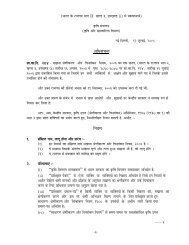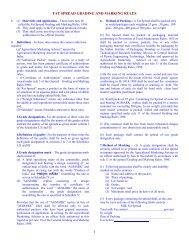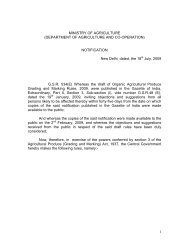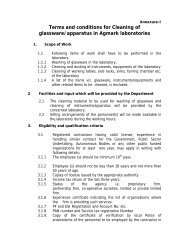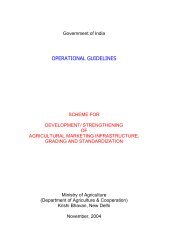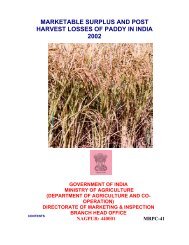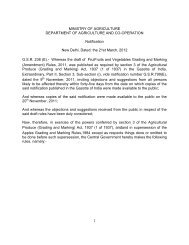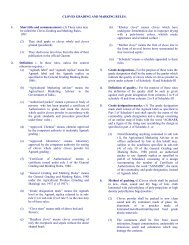Post-harvest profile of red gram - Agmarknet
Post-harvest profile of red gram - Agmarknet
Post-harvest profile of red gram - Agmarknet
You also want an ePaper? Increase the reach of your titles
YUMPU automatically turns print PDFs into web optimized ePapers that Google loves.
species <strong>of</strong> Cajanus are known, differing in height, habit, time <strong>of</strong> maturity, colour, size andshape <strong>of</strong> pods and seeds. All these cultivated types belong to two categories:i) Cajanus cajan var. bicolor: This group includes late maturing varieties, having tall bushyplants and bear flowers at the end <strong>of</strong> the branches. The podsare relatively longer and contain 4-5 seeds.ii) Cajanus cajan var. flavus: This group includes early maturing varieties, having smallerplants and flowers at several points along the branches. Thepods are also shorter which bear 2-3 seeds.1.2 Importance:India alone accounted for about 81 percent <strong>of</strong> total world’s production in the year 2002and 90 percent <strong>of</strong> total world’s consumption <strong>of</strong> Red <strong>gram</strong>. The total pulse production <strong>of</strong> thecountry was 11.08 million tonnes in 2000-01 including Red <strong>gram</strong> (2.25 million tonnes).Generally, this crop is not grown as commercial crop and major portion <strong>of</strong> the produce isconsumed in the respective state itself. Every Red <strong>gram</strong> plant is a mini-fertilizer factory as thecrop has unique characteristics <strong>of</strong> restoring and maintaining soil fertility through fixingatmospheric nitrogen in symbiotic association with Rhizobium bacteria present in the rootnodules. Red <strong>gram</strong> crop is suitable for inter-cropping, with different crops (Cotton, Sorghum,Pearl millet, Green <strong>gram</strong>, Black <strong>gram</strong>, Maize, Soybean, Groundnut) for increasing productionand maintaining soil fertility.2.0 PRODUCTION2.1 Major producing countries in the world:Red <strong>gram</strong> isgrown throughout thetropical and subtropicalcountries <strong>of</strong> the worldespecially in SouthAsia, Eastern andSouthern Africa, LatinAmerica, Caribbeancountries and Australia.According to FAOstatistics, worldwideRed <strong>gram</strong> was grown inabout 4.16 millionhectares and itsproduction was 2.99million tonnes in 2002.India is the largestMajor Red <strong>gram</strong> producing countries during 2002(Percent to world production)3.25 81.492.602.6410.02IndiaMyanmarMalawiUgandaOthersproducer <strong>of</strong> Red <strong>gram</strong> accounting 81.49 percent <strong>of</strong> total production and 80.59 percent <strong>of</strong> totalarea <strong>of</strong> the world. Other major Red <strong>gram</strong> producing countries are Myanmar (10.02 percent),Malawi (2.64 percent) and Uganda (2.60 percent). The productivity is highest in Uganda (1000kg/ha) followed by Nepal (875kg/ha) and India (728 kg/ha).2




